

 Unique, "EB on Breast"
Unique, "EB on Breast"1787 Brasher Doubloon from
The Gold Rush Collection
The 1850s
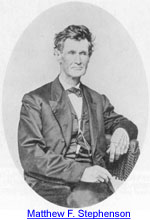 The discovery of gold in California in 1848 played a significant role in the history of the Dahlonega Mint. Although the miners were admonished by the future Dahlonega Mint Assayer Matthew Stephenson not to leave (in his famous "Thar's Gold in Them Thar Hills" speech), Superintendent Redding estimated that 1,800 miners left for the California gold fields.
The discovery of gold in California in 1848 played a significant role in the history of the Dahlonega Mint. Although the miners were admonished by the future Dahlonega Mint Assayer Matthew Stephenson not to leave (in his famous "Thar's Gold in Them Thar Hills" speech), Superintendent Redding estimated that 1,800 miners left for the California gold fields.
The miners brought back gold from California, which they deposited at the Dahlonega Mint, beginning in 1850. By 1851 these deposits exceeded that of Georgia gold. Deposits from California peaked in 1853, amounting to almost 80 percent of the year's receipts.
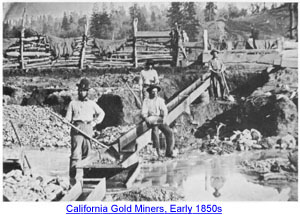
Although deposits in 1854 were down significantly from 1853, due primarily to the opening of the San Francisco Mint (that was much more convenient to the California gold fields), the Dahlonega Mint managed to coin four denominations (dollar, quarter eagle, three dollar, and half eagle), for the first (and only) time in its history. 1854 was the last year of
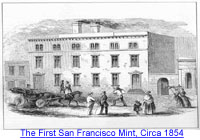 significant deposits of California gold at the Dahlonega Mint. Today, collectors should make note of the fact that a Dahlonega coin minted from 1851 to 1854 probably contains gold from California.
significant deposits of California gold at the Dahlonega Mint. Today, collectors should make note of the fact that a Dahlonega coin minted from 1851 to 1854 probably contains gold from California.

It is interesting to note that the deposit of California gold caused the Dahlonega Mint personnel to modify their normal way of processing the gold. Up until 1850, most of the naturally occurring gold that had been deposited came from the local gold fields and from surrounding states. Most of this Appalachian gold had no more than 5% silver in it. Gold brought back from California had an average of approximately 15% silver. This meant that the California deposits were below the legal fineness (.900), forcing the Dahlonega Mint workmen to part the silver from the gold. On the other hand, the typical course of action with gold that was purer than the legal standard of fineness was to add enough copper to achieve .900 fineness. It would be interesting to try and determine if the use of California gold resulted in an orange gold coloration of the resulting coinage (due to the probability that most of the silver was removed). As previously mentioned, it was standard practice at Dahlonega to leave in the naturally occurring silver if possible (which could run as high as 5% in gold mined locally), which imparted a lighter, green gold hue to the coins.
A lawyer and former state treasurer named Julius Patton was appointed by the recently elected Democrat President Franklin Pierce
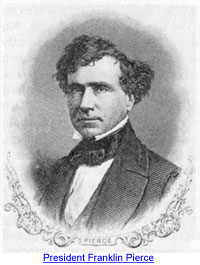 and replaced Redding in July 1853. Patton, a States' Rights Democrat about thirty-five years old, was described as being "efficient without being noisy." Problems faced by Patton included the dilapidated condition of the mint, declining gold deposits, and problems with the coining process.
and replaced Redding in July 1853. Patton, a States' Rights Democrat about thirty-five years old, was described as being "efficient without being noisy." Problems faced by Patton included the dilapidated condition of the mint, declining gold deposits, and problems with the coining process.
In late 1853, the Dahlonega Mint was directed by the Philadelphia Mint to reduce the silver content of the coinage to 8 parts per thousand. Elemental analysis of coins dated 1854 confirm that the silver content was reduced significantly.
The quality of the coins struck at the Dahlonega Mint suffered during the mid-to-late years of the decade. If awards were made for this dubious distinction, they would probably be given to the 1860-D gold dollar, the 1856-D quarter eagle, and the 1855-D half eagle. It is also known that the 1856 assay coins were outside the allowable weight tolerance. As the key production personnel during this era (Coiner John Field and Assayer Isaac Todd)
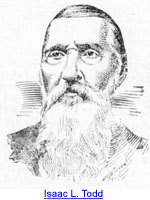 were both experienced, the fault probably lay elsewhere. Both had previously served in the same capacities during the 1840s when the best coinage had been produced (Field from 1848-1849 and Todd from 1843-1850). Likely culprits include soft mill rollers, excessive "work hardening" from supplies of defective copper, and out-of-tolerance weighing scales.
were both experienced, the fault probably lay elsewhere. Both had previously served in the same capacities during the 1840s when the best coinage had been produced (Field from 1848-1849 and Todd from 1843-1850). Likely culprits include soft mill rollers, excessive "work hardening" from supplies of defective copper, and out-of-tolerance weighing scales.
Receipts at the Georgia mint continued to decline in the late 1850s, after the California gold deposits had slowed to a trickle. There was some hope of increasing deposits brought about by several events, including the Findlay Chute discovery in 1857 and the prospects for hydraulic mining by the Yahoola Company in 1859, but history was waiting to intercede.